Unlock the potential of your pet with our essential German Shepherd training guide. A master German Shepherd training guide is crucial for understanding the unique characteristics and needs of the breed. This comprehensive guide will cover topics such as the history, personality, and traits of German Shepherds. It will provide you with expert tips and techniques for raising and socializing your German Shepherd puppy, as well as addressing common behavioral issues that may arise.
By following a German Shepherd training guide, you can expect to see significant improvements in your dog’s behavior and develop a stronger bond with them. This guide will help you enhance your dog’s socialization skills, improve obedience training, reduce anxiety and tension, and establish better communication with your German Shepherd. Additionally, the guide will provide mental stimulation for your dog, leading to a happier and healthier pet.
Key Takeaways:
- Understanding the unique characteristics and traits of German Shepherds is crucial for successful training.
- Raising and socializing German Shepherd puppies require specific techniques to ensure their proper development.
- Addressing common behavioral issues such as barking, digging, and separation anxiety is essential for a well-behaved German Shepherd.
- Positive reinforcement training methods, including rewards and praise, are highly effective for German Shepherds.
- Advanced training techniques, such as agility training and scent work, can provide additional mental and physical stimulation for your German Shepherd.
To effectively train your German Shepherd, it’s important to first understand the breed’s history, personality, and unique traits. German Shepherds are renowned for their intelligence, loyalty, and versatility. Originally bred in Germany in the late 19th century, they were initially used for herding and guarding livestock.
German Shepherds have a strong work drive and thrive when given a purpose. They are highly trainable and excel in various roles, such as police and military work, search and rescue, and service dog tasks. Their natural protective instincts make them excellent family companions and guard dogs.
With their high energy levels, German Shepherds require regular exercise and mental stimulation. They enjoy activities that challenge their intelligence and problem-solving abilities. Proper socialization from an early age is crucial to ensure a well-rounded and well-behaved adult dog.
| Traits | Description |
|---|---|
| Loyalty | German Shepherds are fiercely loyal to their families and form strong bonds with their owners. |
| Intelligence | Ranked as one of the most intelligent dog breeds, German Shepherds are quick learners and excel in obedience training. |
| Protectiveness | German Shepherds have a natural instinct to protect their loved ones and can be vigilant and wary of strangers. |
| Confidence | These dogs possess a confident and self-assured demeanor, which contributes to their ability to excel in various tasks. |
To facilitate successful training and build a strong bond with your German Shepherd, it’s important to tailor training methods to their specific personality and traits. Understanding the breed’s history and characteristics is the foundation for effective German Shepherd training.
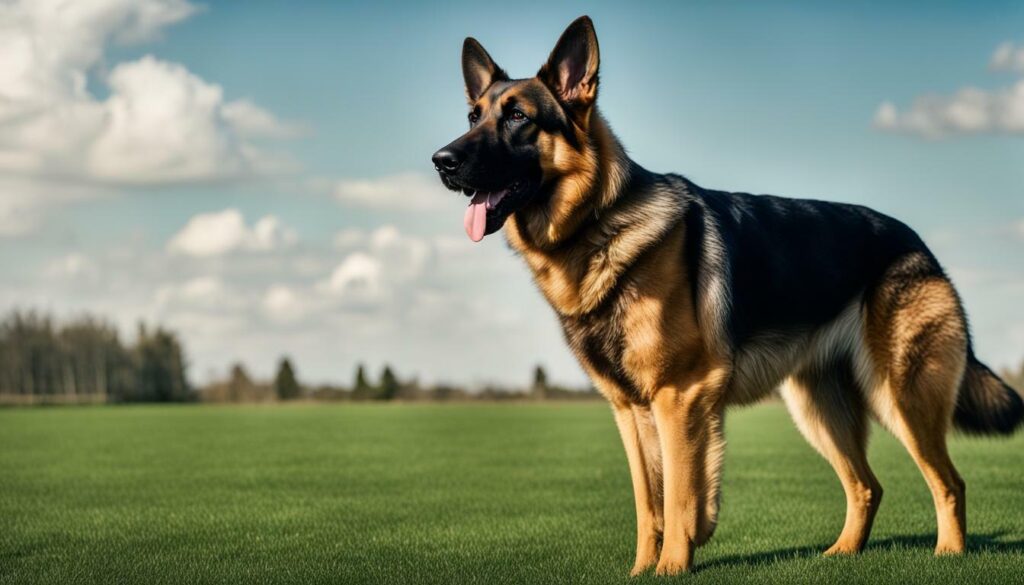
Raising a well-behaved German Shepherd starts with proper puppy training and socialization. It is crucial to provide your puppy with a positive and well-structured environment to ensure they grow up to be confident and obedient adults. Here are some essential tips for raising and socializing your German Shepherd puppy:
Early Socialization
Early socialization is key to helping your German Shepherd puppy develop into a well-rounded and friendly adult dog. Expose your puppy to various people, animals, and environments from a young age. This will help them become familiar with different sights, sounds, and experiences, preventing fear or aggression issues in the future.
Obedience Training
Start obedience training as soon as you bring your German Shepherd puppy home. Teach them basic commands such as sit, down, stay, and come. Use positive reinforcement techniques, such as treats and praise, to motivate and reward your puppy for good behavior. Consistency and patience are essential when training your German Shepherd.
Crate Training
Crate training is an essential part of puppy training for German Shepherds. A crate provides a safe and comfortable space for your puppy and helps with housetraining. Introduce the crate gradually, making it a positive and enjoyable place for your puppy. Use treats and praise to encourage them to enter the crate willingly. Remember, never use the crate as a form of punishment.
| Benefits of Proper Puppy Training and Socialization |
|---|
| Improved behavior |
| Stronger bond with your dog |
| Enhanced socialization skills |
| Improved obedience training |
| Reduced anxiety and tension |
| Better communication with your dog |
| Increased mental stimulation |
By following these tips and techniques, you can lay a solid foundation for your German Shepherd puppy’s training and socialization. Remember to be patient, consistent, and provide plenty of positive reinforcement. With proper guidance and care, your German Shepherd puppy will grow up to be a well-behaved and happy companion.
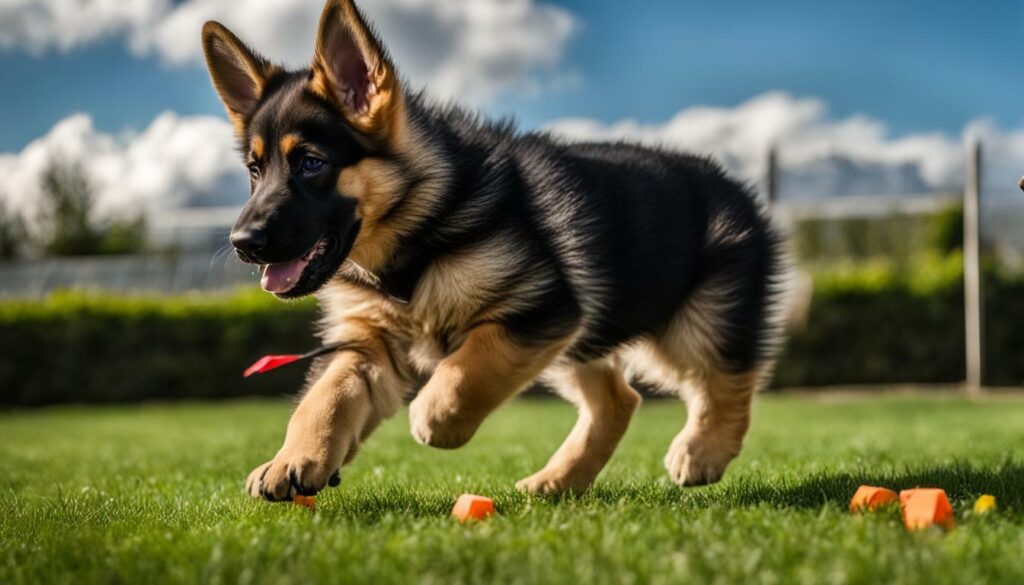
Do not duplicate.
German Shepherds, like any other dog breed, can experience behavioral issues that require proper training and guidance. It’s important to address these issues early on to ensure a happy and well-behaved companion. In this section of our German Shepherd training guide, we will discuss some of the common behavioral problems that German Shepherds may exhibit and provide tips and techniques for effectively addressing them.
Barking:
One common behavioral issue among German Shepherds is excessive barking. They are naturally protective and can be prone to barking at strangers or other animals. To address this, it’s essential to establish yourself as the leader and provide consistent training. Teaching the “quiet” command and rewarding your dog when they stop barking can help curb excessive barking behavior.
Digging:
Another common behavior seen in German Shepherds is digging. They have a strong instinct to dig, which can be triggered by boredom or the desire to hide or find something. Provide mental and physical stimulation through interactive toys, regular exercise, and supervised playtime to redirect their digging behavior. Creating a designated digging area in your yard with loose soil or sand can also help satisfy their instinct.
Separation Anxiety:
German Shepherds are known for their loyalty and can develop separation anxiety when left alone for long periods. This can lead to destructive behavior and excessive barking. To alleviate separation anxiety, gradually acclimate your dog to being alone by starting with short periods and gradually increasing the duration. Providing them with interactive toys and creating a safe and comfortable space can also help ease their anxiety.
By addressing these common behavioral issues with proper training techniques and consistency, you can help your German Shepherd become a well-behaved and happy companion. Remember to be patient and understanding, as every dog is unique and may respond differently to training methods. With time and effort, you can shape your German Shepherd into a well-mannered and obedient dog that brings joy and fulfillment to your life.
| Behavioral Issues | Tips and Techniques |
|---|---|
| Barking | Teach the “quiet” command and reward your dog for stopping barking |
| Digging | Provide mental and physical stimulation, create a designated digging area |
| Separation Anxiety | Gradually acclimate your dog to being alone, provide interactive toys and a safe space |
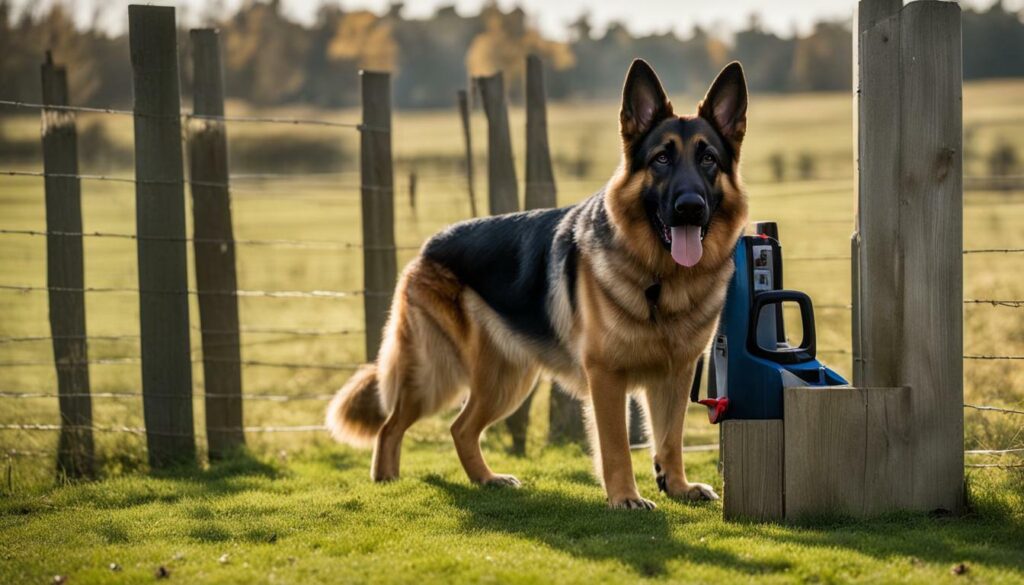
Effective Training Methods
When it comes to training your German Shepherd, positive reinforcement is a highly effective method that encourages good behavior. This training approach focuses on rewarding your dog for desired actions, such as following commands or displaying proper manners.
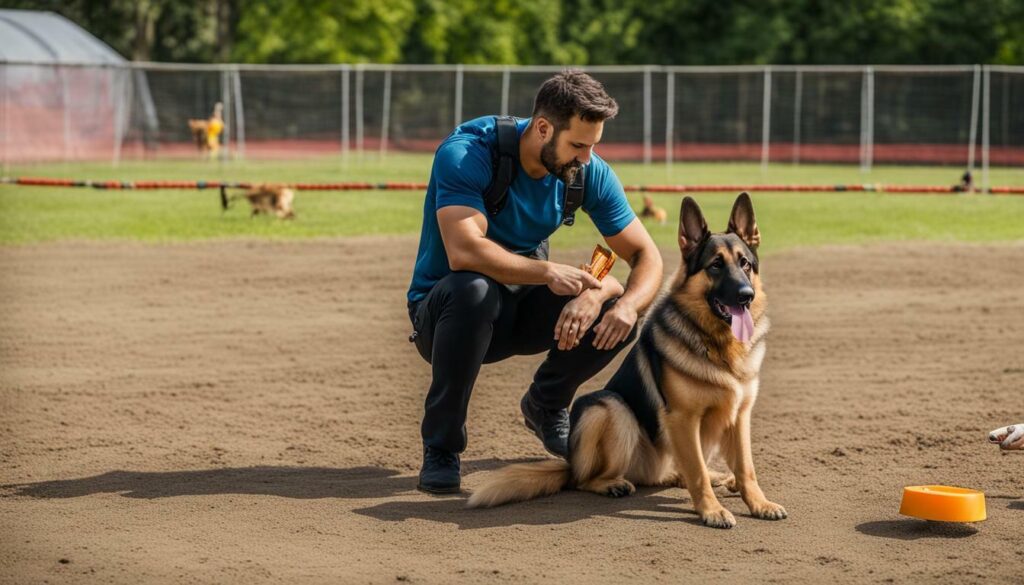
Positive reinforcement can be implemented through various techniques, including clicker training, treat rewards, and verbal praise. By associating positive experiences with specific behaviors, you can motivate your German Shepherd to repeat those actions in the future.
Clicker Training
One popular method of positive reinforcement is clicker training. This technique involves using a small handheld clicker that makes a distinct sound when pressed. The click is immediately followed by a reward, typically a treat, to reinforce the desired behavior.
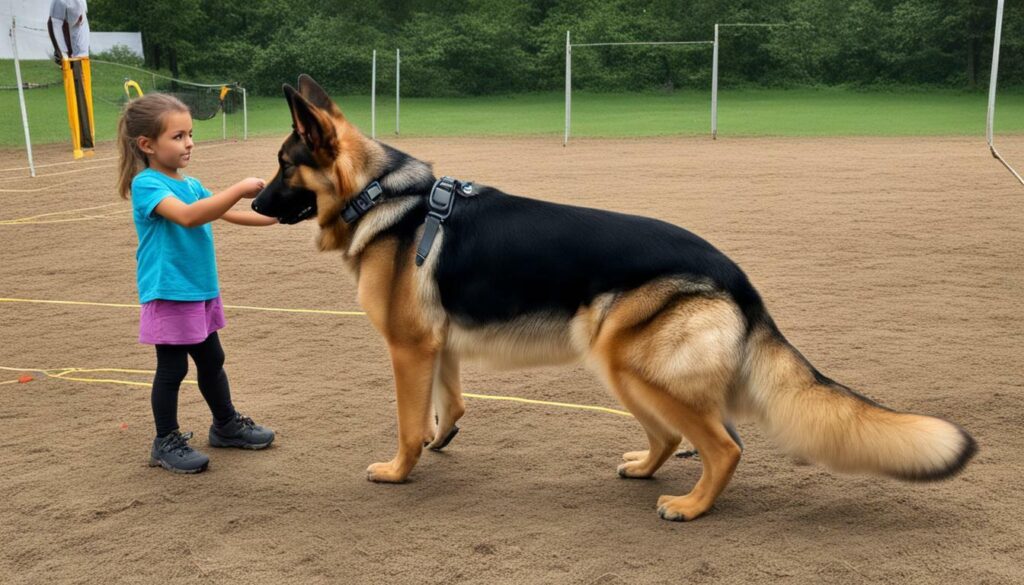
Treat Rewards and Verbal Praise
Another effective approach is rewarding your German Shepherd with treats and verbal praise. When your dog successfully follows a command or demonstrates good behavior, offer a treat along with enthusiastic verbal praise such as “Good boy!” or “Well done!”. This positive reinforcement establishes a positive association between the behavior and the reward, reinforcing the desired actions.
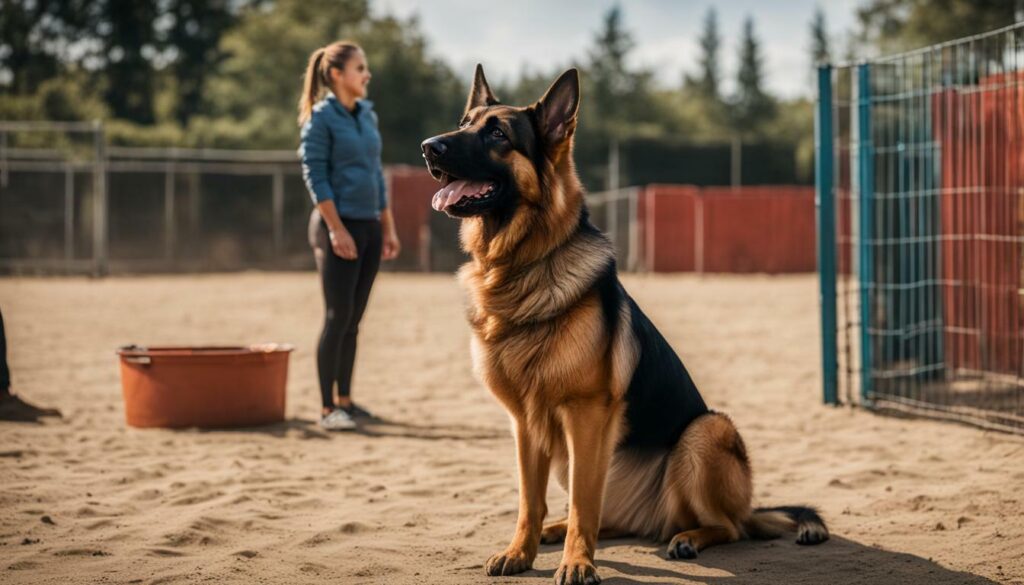
Remember to be consistent, patient, and firm in your training methods. Consistency will help your German Shepherd understand what is expected of them, and patience will allow them time to learn and grow. By using positive reinforcement techniques, you can create a positive and enjoyable training experience for both you and your German Shepherd.
Advanced Training Techniques for German Shepherds
Once you have mastered the basics, advanced training techniques can take your German Shepherd’s skills to the next level. These techniques are designed to challenge your dog mentally and physically, helping them become well-rounded and disciplined canines. From agility training to scent work, here are some advanced training methods that you can incorporate into your German Shepherd’s routine.
Agility Training: Agility training is a popular sport that involves navigating your dog through obstacles such as jumps, tunnels, and weave poles. Not only does it improve your German Shepherd’s physical fitness, but it also enhances their coordination, focus, and problem-solving abilities. Setting up an agility course in your backyard or joining a local agility club can provide your dog with a stimulating and fun training experience.
Scent Work: German Shepherds have an exceptional sense of smell and can be trained to detect specific scents. Scent work involves teaching your dog to identify and locate target odors, such as drugs, explosives, or missing persons. This type of training taps into their natural instincts and provides mental stimulation. Additionally, scent work can be a great form of exercise for your German Shepherd, as they use their nose and brain to solve scent puzzles.
Advanced Obedience Exercises: Take your German Shepherd’s obedience training to the next level by introducing more complex exercises. These can include advanced commands such as retrieving specific objects by name, performing tricks like spinning or bowing, and perfecting off-leash obedience. Remember to break down these exercises into smaller steps and use positive reinforcement to motivate your dog.
| Advanced Training Techniques for German Shepherds | Description |
|---|---|
| Agility Training | Improve physical fitness, coordination, and problem-solving abilities through navigating obstacles. |
| Scent Work | Tap into your German Shepherd’s exceptional sense of smell to identify and locate specific odors. |
| Advanced Obedience Exercises | Take obedience training to the next level by introducing more complex commands and tricks. |
By incorporating these advanced training techniques into your German Shepherd’s routine, you can continue to challenge and stimulate their mind. Remember to always use positive reinforcement, patience, and consistency when training your dog. Enjoy the journey of discovering your dog’s full potential!
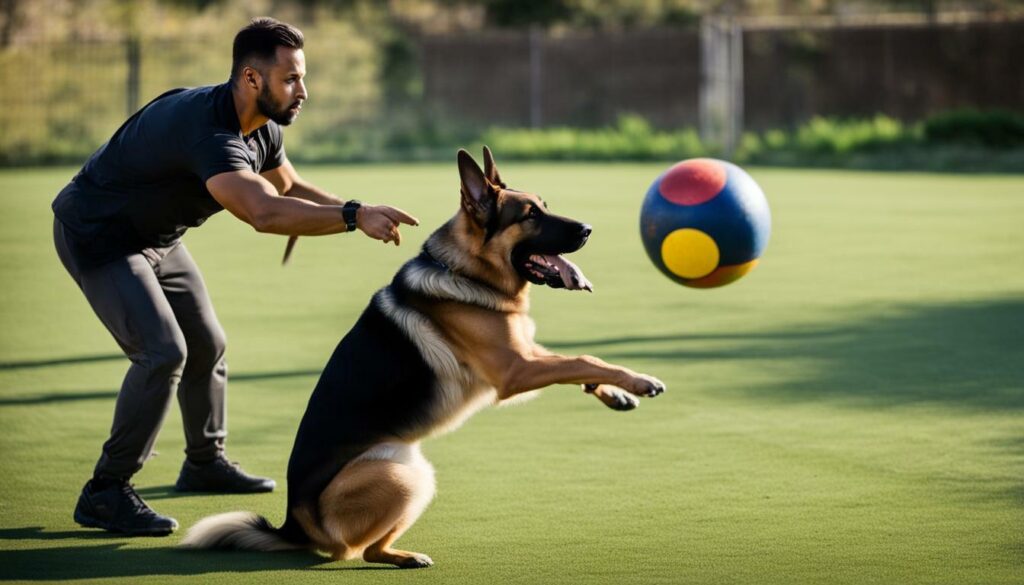
Proper leash training is essential for ensuring a pleasant and controlled walking experience with your German Shepherd. This breed is known for their strong work drive and high energy levels, making it crucial to establish good leash manners from the beginning. By following the right techniques and using positive reinforcement, you can teach your German Shepherd to walk calmly by your side.
Start by selecting a sturdy leash and a well-fitting collar or harness. German Shepherds have a tendency to pull, so using a front-clip harness or a head halter can provide added control. When you begin your training sessions, start in a quiet and familiar environment to minimize distractions.
During the training process, maintain a relaxed grip on the leash and use verbal cues to convey your expectations. Encourage your German Shepherd to walk by your side by using treats or a favorite toy as a reward. When they pull, stop walking and wait for them to return to your side before continuing. Consistency is key, so be patient and reinforce positive behavior consistently.
| Leash Training Tips: |
|---|
| 1. Use a sturdy leash and a well-fitting collar or harness. |
| 2. Begin training in a quiet and familiar environment. |
| 3. Maintain a relaxed grip on the leash and use verbal cues. |
| 4. Reward your German Shepherd for walking calmly by your side. |
| 5. Stop walking when your dog pulls and wait for them to return. |
Leash Training Tips:
- Use a sturdy leash and a well-fitting collar or harness.
- Begin training in a quiet and familiar environment.
- Maintain a relaxed grip on the leash and use verbal cues.
- Reward your German Shepherd for walking calmly by your side.
- Stop walking when your dog pulls and wait for them to return.
Remember to make the training sessions fun and enjoyable for your German Shepherd. Use positive reinforcement, such as treats and praise, to reward good behavior. With consistent training and patience, your German Shepherd will learn to walk calmly on a leash, allowing you to enjoy pleasant walks together.
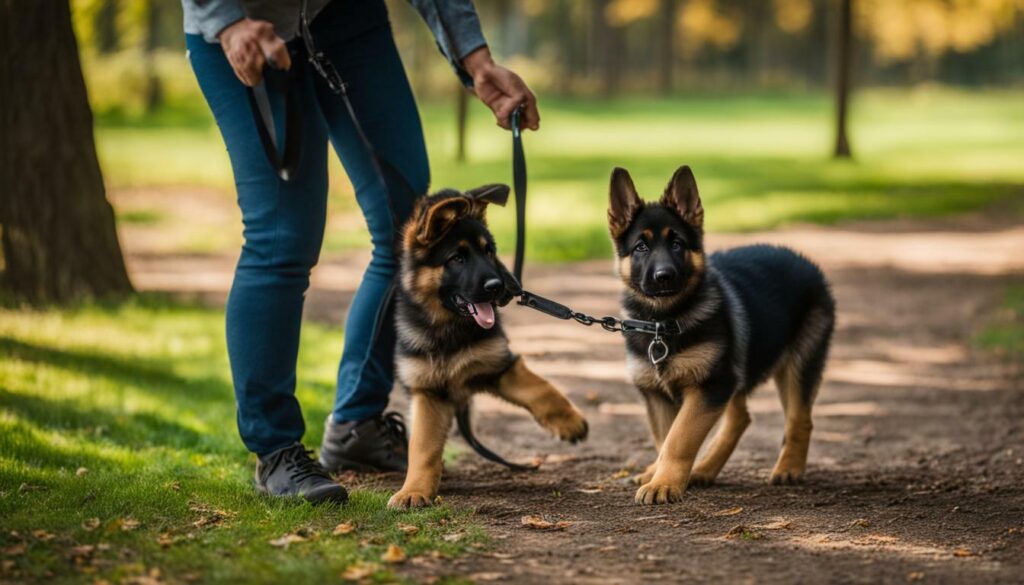
German Shepherds have unique characteristics that require specific training approaches to ensure their full potential is realized. As intelligent and driven dogs, they excel in various roles, including police work, search and rescue, and as loyal family companions. To harness their exceptional abilities, a comprehensive German Shepherd training guide should address their specific traits and instincts.
First and foremost, German Shepherds have a strong work drive. They thrive when given tasks and responsibilities, making them excellent candidates for advanced training techniques such as agility and scent work. Incorporating these activities into their training not only keeps them mentally stimulated but also helps them channel their energy in a positive and productive way.
Additionally, German Shepherds have a natural guarding instinct. While this trait can be advantageous, it also requires careful training to ensure it is directed appropriately. A well-rounded German Shepherd training plan should include exercises that reinforce the distinction between protective behavior and aggressive tendencies, ensuring your dog is a reliable and controlled member of your household.
German Shepherd-Specific Training Tips:
- Emphasize mental stimulation and physical exercise to keep your German Shepherd engaged and prevent boredom.
- Establish clear boundaries and consistent rules to help your German Shepherd understand their role and responsibilities within the household.
- Expose your German Shepherd to various social situations and environments from a young age to promote proper socialization and reduce anxiety.
- Utilize positive reinforcement techniques to reinforce desired behaviors and discourage unwanted ones, as German Shepherds respond well to praise and rewards.
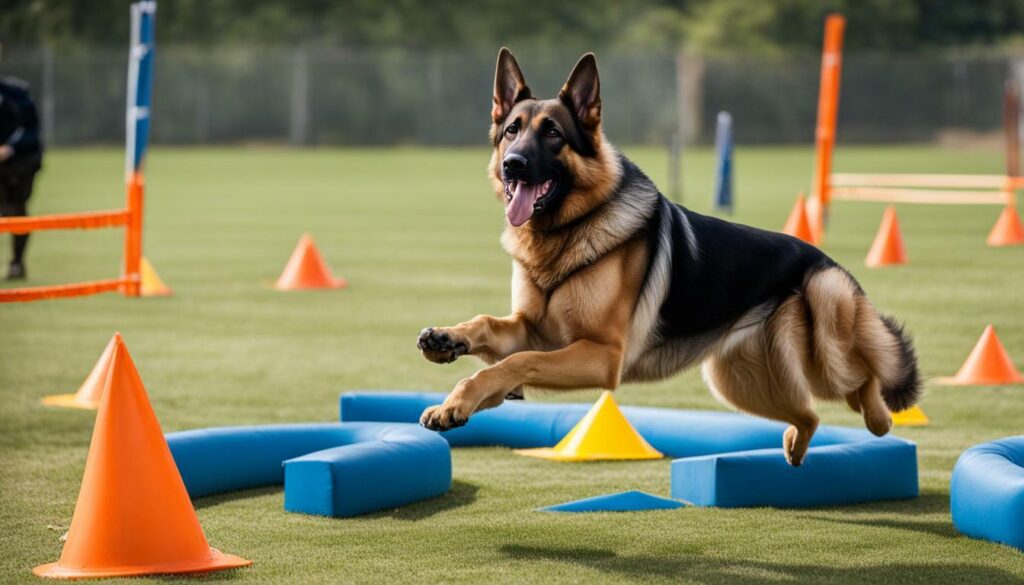
| Training Method | Benefits |
|---|---|
| Agility training | Enhances agility, coordination, and mental sharpness |
| Scent work | Utilizes a German Shepherd’s exceptional nose and tracking abilities |
| Obedience exercises | Builds a strong foundation for reliable obedience and control |
Crate Training, Housetraining, and Obedience Training
Crate training, housetraining, and obedience training are fundamental aspects of raising a well-behaved German Shepherd. A comprehensive German Shepherd training guide should include step-by-step instructions for each of these training methods.
Crate training provides your German Shepherd with a safe and comfortable space that they can call their own. It helps with housetraining by teaching them to hold their bladder and bowels until they can be taken outside. Additionally, a crate-trained dog is less likely to engage in destructive behaviors when left alone.
Housetraining is crucial for teaching your German Shepherd where it is acceptable to relieve themselves. Consistency, patience, and positive reinforcement are key when housetraining your puppy. This will establish a routine and help them learn to ask for bathroom breaks when needed.
Obedience training is essential for establishing control and effectively communicating with your German Shepherd. Basic commands, such as sit, down, stay, come, and heel, should be taught early on. Training sessions should be short, positive, and consistent to ensure your dog understands and responds to your commands.
FAQ
What is the importance of a German Shepherd training guide?
A German Shepherd training guide is essential for understanding the unique characteristics and needs of the breed. It provides tips and techniques for raising and socializing puppies, addressing common behavioral problems, and improving obedience training.
What are the benefits of following a German Shepherd training book?
Following a German Shepherd training book can lead to improved behavior, a stronger bond with your dog, enhanced socialization skills, improved obedience training, reduced anxiety and tension, better communication with your dog, and increased mental stimulation.
What are some basic commands that should be taught to German Shepherds?
Basic commands that should be taught include sit, down, stay, come, speak, quiet, wait, watch me, leave it, drop it, stand, settle, and heel.
What topics should be covered in a German Shepherd training guide?
A German Shepherd training guide should cover topics such as the history, personality, and traits of German Shepherds. It should also provide tips and techniques for raising and socializing puppies, as well as addressing common behavioral problems. Crate training, housetraining, and obedience training should also be included.
What are some specific training considerations for German Shepherds?
German Shepherds have a strong work drive, guarding instincts, and intelligence. A German Shepherd training guide should provide guidance on how to channel these traits in a positive and productive way.

Marissa Delotta, 36, from Dayton, Ohio, is the creative force behind Roverboard.com, a beloved online destination for dog lovers. As a dedicated mom and canine enthusiast, Marissa combines her family experiences with her love for dogs to offer a platform where dog owners can exchange tips, heartwarming stories, and advice. Her website has become a vibrant community for sharing the joys of dog parenting. In her free time, Marissa enjoys exploring dog parks with her family and volunteering at local animal shelters.